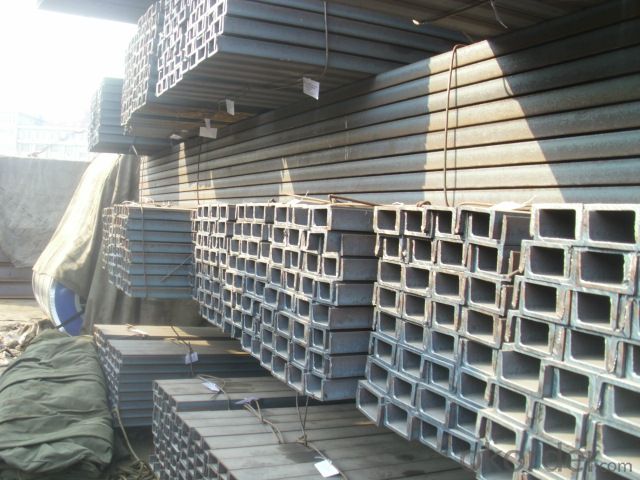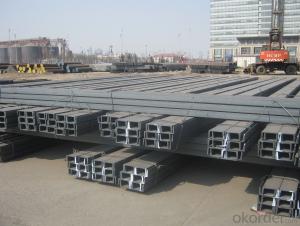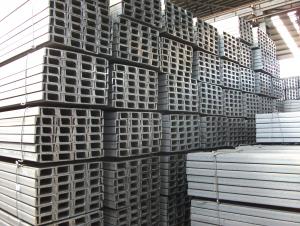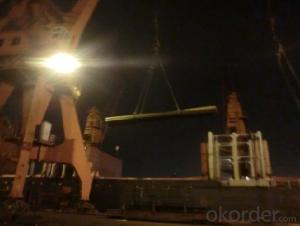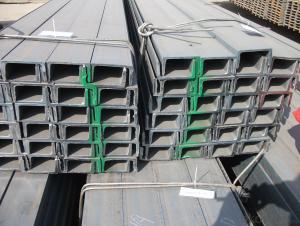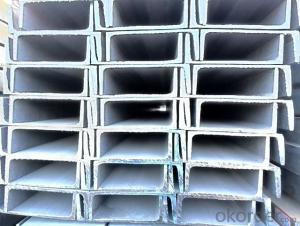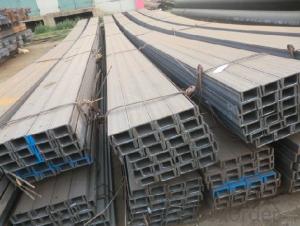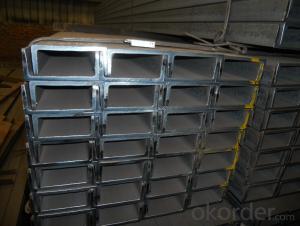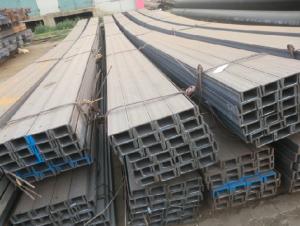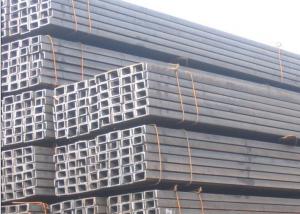Hot Rolled U-channel Steel Many Standards High Quality
- Loading Port:
- China Main Port
- Payment Terms:
- TT or LC
- Min Order Qty:
- -
- Supply Capability:
- -
OKorder Service Pledge
OKorder Financial Service
You Might Also Like
Product Description:
OKorder is offering STEEL CHANNEL at great prices with worldwide shipping. Our supplier is a world-class manufacturer of steel, with our products utilized the world over. OKorder annually supplies products to European, North American and Asian markets. We provide quotations within 24 hours of receiving an inquiry and guarantee competitive prices.
Product Applications:
The steel u channel can be applied to construction of warehouses, workshops, sport stadiums and car parks etc. In details, the steel u channel belongs to carbon structural steel which is applied to in the field of construction and machinery. The steel u channel is usually used for arch-itechtural structure, and they could be welded in order to support or hang a vari-ety of facilities. They are also usually used in combination with I beam. Generally,the steel u channel must possess perfect welding property, riveting property and mechanical property and so on.
Product Advantages:
OKorder's STEEL CHANNELare durable, strong, and resist corrosion.
Main Product Features:
· Premium quality
· Prompt delivery & seaworthy packing (30 days after receiving deposit)
· Corrosion resistance
· Can be recycled and reused
· Mill test certification
· Professional Service
· Competitive pricing
Product Specifications:
Standard | GB/JIS |
Material Grade | Q235,SS400 |
Technique: | Hot Rolled |
Sizes as per chinese standard: | 50*37*4.5mm - 300*89*11.5mm
|
Sizes as per japanese standard: | 50*25*3mm – 200*80*7.5mm |
Length: | 6meter, 9meter, 12meter |
Production Flow of JIS Channel:
1.The steel billet shall be heated in the high temperature furnace.
2. The heated steel billet shall be rolled five to nine times with the aim of shaping the general figure of steel u channel.
3. The rolled steel channel should be put onto the cooling bed to make the temperature low.
4. The JIS Channel should be straighted on the straightener.
5. The straighted steel u channel will be cut into meters by saw, as per customer's requirements.
6. At the last part of production, the channel steel must be tested in order to confirm that the finished products are completely free from crack, pore, slag, scab or fold on the surface.
| JIS U CHANNEL | Standard h | Sectional b | Dimension s | t | Mass: Kg/m |
| (mm) | (mm) | (mm) | (mm) | ||
| 50x25 | 50 | 25 | 3.0 | 6.00 | 2.37 |
| 75X40 | 75 | 40 | 3.8 | 7.00 | 5.30 |
| 75X40 | 75 | 40 | 4.0 | 7.00 | 5.60 |
| 75X40 | 75 | 40 | 4.5 | 7.00 | 5.85 |
| 75X40 | 75 | 40 | 5.0 | 7.00 | 6.92 |
| 100X50 | 100 | 50 | 3.8 | 6.00 | 7.30 |
| 100X50 | 100 | 50 | 4.2 | 6.00 | 8.03 |
| 100X50 | 100 | 50 | 4.5 | 7.50 | 8.97 |
| 100X50 | 100 | 50 | 5.0 | 7.50 | 9.36 |
| 125X65 | 125 | 65 | 5.2 | 6.80 | 11.66 |
| 125X65 | 125 | 65 | 5.3 | 6.80 | 12.17 |
| 125X65 | 125 | 65 | 5.5 | 8.00 | 12.91 |
| 125X65 | 125 | 65 | 6.0 | 8.00 | 13.40 |
| 150x75 | 150 | 75 | 5.5 | 7.30 | 14.66 |
| 150x75 | 150 | 75 | 5.7 | 10.00 | 16.71 |
| 150x75 | 150 | 75 | 6.0 | 10.00 | 17.90 |
| 150x75 | 150 | 75 | 6.5 | 10.00 | 18.60 |
FAQ:
Q1: Why buy Materials & Equipment from OKorder.com?
A1: All products offered byOKorder.com are carefully selected from China's most reliable manufacturing enterprises. Through its ISO certifications, OKorder.com adheres to the highest standards and a commitment to supply chain safety and customer satisfaction.
Q2: How do we guarantee the quality of our products?
A2: We have established an advanced quality management system which conducts strict quality tests at every step, from raw materials to the final product. At the same time, we provide extensive follow-up service assurances as required.
Q3: How soon can we receive the product after purchase?
A3: Within three days of placing an order, we will begin production. The specific shipping date is dependent upon international and government factors, but is typically 7 to 10 workdays.
Images:
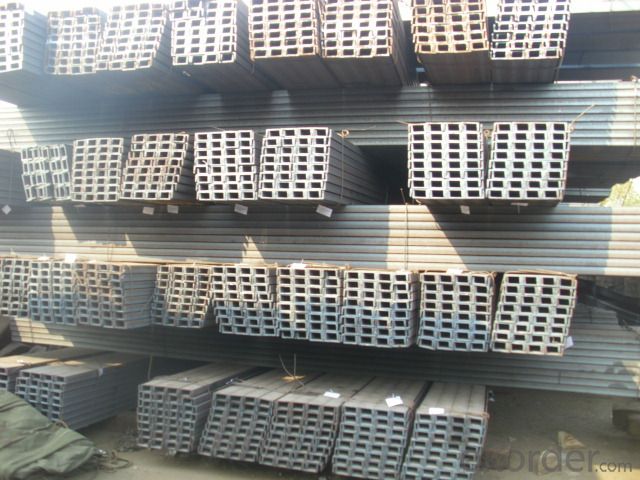

- Q: Can steel channels be used for overhead crane systems?
- Yes, steel channels can be used for overhead crane systems. Steel channels provide the necessary strength and stability required for supporting the weight and movement of overhead cranes, making them a suitable choice for such systems.
- Q: Can steel channels be used in the construction of pedestrian bridges?
- Indeed, the utilization of steel channels is viable for the construction of pedestrian bridges. Owing to their exceptional robustness and longevity, steel channels are frequently employed as fundamental components in bridge construction. They offer the indispensable reinforcement and steadiness required for pedestrian bridges, ensuring a reliable and secure crossing. Moreover, the fabrication and installation of steel channels are straightforward, rendering them a pragmatic selection for bridge construction endeavors.
- Q: Are steel channels suitable for use in exhibition displays?
- Yes, steel channels can be suitable for use in exhibition displays. Steel channels are often chosen for their strength and durability, making them capable of supporting heavy display materials such as panels, graphics, and signage. They can be easily customized to fit different design requirements and can provide a sleek and modern look to exhibition displays. Additionally, steel channels can be powder-coated or painted to match the desired color scheme, further enhancing the overall aesthetic appeal of the display. However, it is important to consider the specific needs of the exhibition and the weight and size of the materials being displayed to ensure that steel channels are the most appropriate choice.
- Q: What are the different types of surface treatments for steel channels in marine applications?
- There are several different types of surface treatments for steel channels used in marine applications. These treatments are designed to enhance the durability and corrosion resistance of the steel in harsh marine environments. One common surface treatment is hot-dip galvanizing. In this process, the steel channel is dipped into a bath of molten zinc, which forms a protective coating on the surface. This coating acts as a barrier against corrosion, protecting the steel from the corrosive effects of saltwater and other marine elements. Another option is epoxy coating. This involves applying a layer of epoxy paint to the surface of the steel channel. The epoxy creates a protective barrier, preventing water and oxygen from reaching the steel and causing corrosion. Epoxy coatings can be particularly effective in marine environments where there is a high risk of abrasion or impact. In addition to galvanizing and epoxy coating, there are also other surface treatments available for steel channels in marine applications. These include metalizing, which involves spraying molten metal onto the surface of the steel to provide a protective coating, and electroplating, which involves depositing a layer of metal onto the surface of the steel using an electric current. Furthermore, some manufacturers offer specialized marine coatings that are specifically formulated to withstand the unique challenges of marine environments. These coatings may contain additives or compounds that provide enhanced corrosion resistance and durability. Ultimately, the choice of surface treatment for steel channels in marine applications will depend on factors such as the specific environment, the level of corrosion resistance required, and the budget. It is important to consult with a corrosion specialist or an engineer to determine the most suitable surface treatment for a particular marine application.
- Q: I encountered in the construction of 2 short 28# channel welding, processed into beams, how to weld? Do I have to have stiffened panels? How many pieces? What's the thickness of the stiffener? I heard that there is a book called "metal processing manual", which has instructions, but I do not have the book. Please give settlement.
- Manual arc welding and J422 (E4303) welding electrodes can be used.Take the side of the web welded stiffening plate (channel steel, in the inner side of the groove with stiffening plate), the wing plate with open groove back sealing welding, welding before welding groove groove cutting slag and its inclusion must be cleared; after welding inspection. The web stiffener is greater than or equal to the thickness of the web. The dimension of the reinforcing plate is: the length of the steel plate is equal to the height of the section steel, and the width is equal to the height of the section steel, minus 70mm.
- Q: What are the different types of connections for steel channels in modular construction?
- In modular construction, steel channels are commonly used for structural purposes due to their strength and versatility. There are several types of connections that can be used with steel channels in modular construction. These connections are designed to provide structural integrity and stability to the modular building. One of the most common types of connections for steel channels is bolted connections. Bolted connections involve the use of bolts to connect two or more steel channels together. This type of connection is relatively easy to install and provides excellent strength and stability. Bolted connections can be used in various configurations, such as end-to-end connections or connections at angles. Welded connections are another popular type of connection for steel channels in modular construction. Welded connections involve the fusion of two or more steel channels using heat and pressure. This type of connection provides a strong and durable bond between the channels, ensuring structural stability. Welded connections are commonly used in applications where high load-bearing capacity is required. Another type of connection for steel channels is the use of brackets or cleats. Brackets or cleats are metal pieces that are attached to the steel channels using bolts or welds. These brackets or cleats provide additional support and reinforcement to the connection, enhancing the overall strength and stability of the modular structure. In some cases, steel channels in modular construction may also be connected using adhesive or epoxy. Adhesive connections involve the use of high-strength adhesives or epoxy resins to bond the steel channels together. This type of connection is often used in applications where a seamless and aesthetically pleasing finish is desired. It is important to note that the type of connection used for steel channels in modular construction depends on factors such as the load-bearing requirements, the specific modular design, and the construction method. It is crucial to work with experienced engineers and construction professionals to determine the most suitable connection type for a specific modular construction project.
- Q: Can steel channels be used for staircases?
- Steel channels are indeed suitable for the construction of staircases. In the field of construction, steel channels are frequently employed due to their robustness and longevity. They are capable of providing a solid structure for staircases, effectively bearing the weight of individuals who utilize them. Furthermore, steel channels can be tailored to perfectly fit the precise measurements and design specifications of the staircase. They can also be manufactured with a range of finishes and coatings, thereby improving their visual appeal and safeguarding against corrosion. In summary, steel channels present a dependable and adaptable choice for the construction of staircases.
- Q: How do steel channels contribute to daylighting in buildings?
- Steel channels can contribute to daylighting in buildings by providing structural support for large windows or skylights. By using steel channels as framing elements, architects and engineers can create expansive openings in walls or roofs, allowing natural light to penetrate deep into the interior spaces of a building. These channels can be designed to withstand the loads imposed by the windows or skylights, ensuring their stability and longevity. Additionally, steel channels can be utilized to create innovative daylighting systems, such as light shelves or light tubes, which enhance the distribution of natural light throughout the building. Overall, steel channels play a crucial role in maximizing daylighting in buildings, improving the quality of indoor spaces, reducing the need for artificial lighting, and promoting energy efficiency.
- Q: What are the different types of connections for steel channels in curtain wall systems?
- There are several different types of connections that can be used for steel channels in curtain wall systems. Some of the most common types include: 1. Bolted Connections: This type of connection involves using bolts to secure the steel channels to other structural elements or to the curtain wall system. Bolted connections are often preferred for their simplicity and ease of installation. 2. Welded Connections: Welding involves fusing the steel channels to other structural elements or to the curtain wall system using heat. Welded connections provide a strong and durable bond, but they require skilled labor and can be more time-consuming to install. 3. Clamped Connections: Clamped connections involve using clamps or brackets to hold the steel channels in place. This type of connection is often used when there is a need for adjustability or when it is desirable to avoid drilling or welding. 4. Adhesive Connections: Adhesive connections involve using high-strength adhesives or epoxy to bond the steel channels to other structural elements or to the curtain wall system. Adhesive connections provide a clean and aesthetically pleasing look, but they may not be suitable for all applications. 5. Combination Connections: In some cases, a combination of different connection types may be used to achieve the desired strength, adjustability, or aesthetic appearance. For example, a curtain wall system may use bolted connections for primary structural support and clamped connections for secondary support or adjustability. It is important to note that the choice of connection type will depend on various factors such as the specific requirements of the project, the load-bearing capacity needed, the architectural design, and the availability of materials and skilled labor. Consulting with a structural engineer or curtain wall specialist is recommended to determine the most appropriate connection type for a given application.
- Q: What does channel 150*8 mean?
- As for the 150*8, it is likely to be a custom tagging method within the factory, which can be viewed from the sourceIf you guess by the results, it should be refers to the waist thickness of 8mm, leg width of 150mm of a certain type of channel.
Send your message to us
Hot Rolled U-channel Steel Many Standards High Quality
- Loading Port:
- China Main Port
- Payment Terms:
- TT or LC
- Min Order Qty:
- -
- Supply Capability:
- -
OKorder Service Pledge
OKorder Financial Service
Similar products
Hot products
Hot Searches
Related keywords





